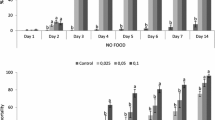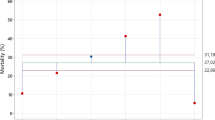Abstract
A series of experiments were conducted in which adults, pupae, and 4-week-old larvae of Tribolium castaneum (Herbst), the red flour beetle, were exposed separately on concrete arenas partially treated (14.4% of the total area) with the insecticide chlorfenapyr (Phantom®) at 1.1 g of active ingredient/m2. A flour food source (patch) was also provided in the untreated portions of the arenas. In the first trial, adult mortality averaged 60.0 ± 10.6%, but progeny production occurred in the provided food patches. Pupal mortality was only 8.3 ± 3.1%, indicating that when adult emergence occurred, those adults were able to escape exposure, and there was no difference in progeny production from that in untreated controls (P = 0.27). In the second trial, few larvae exposed in choice and no-choice arenas were able to emerge as normal adults. In a final trial, residual efficacy declined during a 3-week period, with larvae being more susceptible than adults. Results show mobility of life stage may be a determining factor when assessing susceptibility of T. castaneum to contact insecticides.


Similar content being viewed by others
References
Arthur FH (2008) Efficacy of chlorfenapyr against adult Tribolium castaneum and Tribolium confusum (Coleoptera: Tenebrionidae) exposed on concrete, vinyl tile, and plywood surfaces. J Stored Prod Res 44:145–151
Arthur FH (2009) Efficacy of chlorfenapyr against adult Tribolium castaneum exposed on concrete: effects of exposure interval, concentration, and the presence of a food source after exposure. Insect Sci 16:157–163
Arthur FH (2010) Residual efficacy of aerosols to control Tribolium castaneum and Tribolium confusum. In: Carvalho MO et al (eds) Proceedings of the 10th international working conference on stored product protection, June 28 to July 3, 2010, Estoril, PT, Julius Kühn-Institut, Berlin, Germany, pp 788–791
Arthur FH, Campbell JF (2008) Distribution and efficacy of pyrethrin aerosol to control Tribolium confusum (Coleoptera: Tenebrionidae) in food storage facilities. J Stored Prod Res 44:58–64
Campbell JF, Hagstrum DW (2002) Patch exploitation by Tribolium castaneum: Movement patterns, distribution, and oviposition. J Stored Prod Res 38:55–68
Campbell JF, Runnion C (2003) Patch exploitation by female red flour beetles, Tribolium castaneum. J Insect Sci 3:20. Available online: insectscience.org/3.20
Campbell JF, Toews MD, Arthur FH, Arbogast RT (2010a) Long term monitoring of Tribolium castaneum populations in two flour mills: rebound after fumigation. J Econ Entomol 103:1002–1011
Campbell JF, Toews MD, Arthur FH, Arbogast RT (2010b) Long term monitoring of Tribolium castaneum in two flour mills: seasonal patterns and impact of fumigation. J Econ Entomol 103:991–1001
Hinton, HE (1945) A monograph of the beetles associated with stored products, vol 1, Trustees of the British museum of natural history
McLeod P, Diaz FJ, Johnson DT (2002) Toxicity, persistence, and efficacy of spinosad, chlorfenapyr, and thiamethoxam on eggplant when applied against the eggplant flea beetle (Coleoptera: Chrysomelidae). J Econ Entomol 95:331–335
SAS Institute (2007) The SAS system version 9 for windows. SAS Institute, Cary
Toews MD, Campbell JF, Arthur FH, West M (2005) Monitoring Tribolium castaneum (Herbst) (Coleoptera: Tenebrionidae) in pilot scale warehouses treated with residual applications of (S) hydroprene and cyfluthrin. J Econ Entomol 98:1391–1398
Toews MD, Arthur FH, Campbell JF (2009) Monitoring Tribolium castaneum (Herbst) in pilot-scale warehouses treated with ß-cyfluthrin: are residual insecticides and trapping compatible? Bull Entomol Res 99:121–129
Toews MD, Arthur FH, Campbell JF (2010) The presence of flour affects the efficacy of aerosolized insecticides used to treat the red flour beetle, Tribolium castaneum. J Insect Sci 10:196. Available online: insectscience.org/10.196
Wiltz BA, Suiter DR, Gardner WA (2009) Activity of bifenthrin, chlorfenapyr, fipronil, and thiamethoxam against Argentine ants (Hymenoptera: Formicidae). J Econ Entomol 102:2279–2288
Acknowledgments
The authors thank BASF Corporation for product samples and financial assistance for the study. We also thank B. D. Barnett for technical assistance with this research. We also thank D. Suiter for reviewing a draft of this paper prior to journal submission. This paper reports the results of research only. Mention of trade names or commercial products in this publication is solely for the purpose of providing specific information and does not imply recommendation or endorsement by the US Department of Agriculture (USDA). The USDA is an equal opportunity provider and employer.
Author information
Authors and Affiliations
Corresponding author
Additional information
Communicated by C. G. Athanassiou.
Rights and permissions
About this article
Cite this article
Arthur, F.H., Fontenot, E.A. Food source provisioning and susceptibility of immature and adult Tribolium castaneum on concrete partially treated with chlorfenapyr (Phantom®). J Pest Sci 85, 277–282 (2012). https://doi.org/10.1007/s10340-011-0380-3
Received:
Accepted:
Published:
Issue Date:
DOI: https://doi.org/10.1007/s10340-011-0380-3




